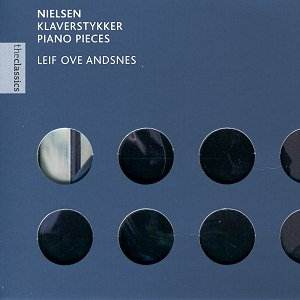Mina Miller's recording of the complete Nielsen piano
music used to be a mainstay of the Hyperion LP catalogue. Somehow it
never made it onto CD ... at least not for Hyperion. In fact it was
then licensed to Jesper Bühl's company Danacord who steadfastly
keep the set in currency. Miller was, I seem to recall, rather good
in her Nielsen but Andsnes strikes me as outstanding. The only real
downside is that this is a rather parsimoniously timed anthology running
five or six minutes short of an hour let alone being anywhere near 79
minutes!
Nielsen's piano music is still fairly obscure so having
his strongest pieces in such visionary performances from Andsnes makes
for potent advocacy. Heavens … the next thing you know Andsnes might
feel moved to record collections of Langgaard, Holmboe, Saar and Tubin.
We can live in hope!
The Chaconne is elegant and touched with
the enchantment of a Chopin mazurka. Andsnes is terse and bullish in
the Den Luciferiske suite Op. 45. Here Nielsen wrote one
of his most revolutionary works; rather like Cowell and starry skies.
This contrasts with the robust heroics of the suite's molto adagio.
The composer's heritage from Bach and Grieg is also discernible. The
final piece in the group is alive with sturdy fantasy. After this twenty
minute suite comes the Op. 50 triptych. These pieces speak of
dislocated universes and feature a strong rhythmic tread - a Bartókian
'footprint'. They often express themselves through a determined gawkiness
and rustic ecclesiatical serenity. I thought of Conlon Nancarrow when
hearing the quiet rapid running rivulets and dissonance in this sequence.
Ravel in haunted Pierrot weeds can also be heard. From very early on
come the Five Pieces. Grieg and Bach are once again the
exemplars. A cool innocence I associate with Chopin appears in several
of these pieces. Also of early vintage is the Op. 11 Humoresk
sequence with its collision between Handelian quietude, Chopin waltzes,
gawky elegance (in Sprællemanden, tr. 19) and toy-box Mozartian
carillons (Spilleværket, tr. 21)
The notes are by Nielsen expert, Robert Layton with
an additional personal note on the Chaconne by Leif Ove Andsnes.
Rob Barnett
